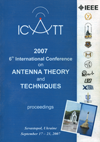Microwave spherical focusing systems
DOI:
https://doi.org/10.1109/ICATT.2007.4425108Keywords:
method of regularization, spherical reflector, focal studies, multi-beam antenna, spherical lensAbstract
Microwave focusing systems of spherical shape (constant K-lens, Luneberg lens and spherical reflector antenna) are investigated. The corresponding wave scattering problems are treated as classical boundary value problems for Maxwell's equations. The systems are illuminated by an electromagnetic plane wave (receiving) and by a complex-point huy-gens source producing a Gaussian beam-like radiation (transmitting). In the case of a spherical lens the electromagnetic field has an explicit mie series representation. When investigating the spherical reflector antenna and spherical lens reflectors we employ the rigorous method of regularization. This method provides stable and fast converging computational algorithms, which guarantee any desired accuracy of the computations. The specific computational tools are implemented to advance into the deep quasi-optical region, where electrical size of an aperture D/lambda is specified by thousands. These advances are employed for comprehensive analysis of the giant spherical reflector antennas (up to D/lambda = 10000). The performance of low-profile multi-beam antennas based on spherical lenses is examined when the interference between beams is "automatically" incorporated into the general solution. The comparative analysis of the Luneberg lens and Constant-K lens reflectors is performed in a wide frequency range.References
STRATTON, A. Electromagnetic Theory. New York: McGraw-Hill, 1941.
ASSALY, R.N. Experimental investigation of a homogeneous dielectric sphere as a microwave lens. Can. J. Phys., 1958, v.36, n.10, p.1430-1435, doi: http://dx.doi.org/10.1139/p58-142.
CHESTON, T.C.; LUOMA, E.J. APL Tech. Dig., 1963, p.8-11.
VINOGRADOV, S.S.; SHESTOPALOV, V.P. Solution of a vector scattering problem for a sphere with a hole. Sov. Phys. Doklady, 1977, p.237.
VINOGRADOV, S.S.; SMITH, P.D.; VINOGRADOVA, E.D. Canonical Problems in Scattering and Potential Theory. Part 2: Acoustic and Electromagnetic Diffraction by Canonical Structures. Chapman & Hull/CRC, 2002.
NICOLIC, N.; KOT, J.S.; VINOGRADOV, S.S. Scattering by a Luneberg lens partially covered by a metallic cap. J. Electr. Waves Appl., 2007, v.21, n.4, p.549-563, doi: http://dx.doi.org/10.1163/156939307780616856.
VINOGRADOV, S.S.; SMITH, P.D.; KOT, J.S.; NICOLIC N. Radar cross-section studies of spherical lens reflector. Progress in Electromagnetic Research, 2007, v.72, p.325-337, doi: http://dx.doi.org/10.2528/PIER07031206.
SPENCER, R.K.; HYGE, G. Studies of the focal region of a spherical reflector. IEEE Trans. Antennas Propag., May 1968, v.16, n.3, p.317-324, doi: http://dx.doi.org/10.1109/TAP.1968.1139187.
JI, YU; HONGO, K. Field in the focal region of a dielectric spherical lens. J. Opt. Soc. Am. A, 1991, v.8, n.11, p.1721-1728, doi: http://dx.doi.org/10.1364/JOSAA.8.001721.
GREENWOOD, A.D.; JIN, J.-M. A field picture of wave propagation in inhomogeneous dielectric lenses. IEEE AP Magazine, Oct. 1999, v.41, n.5, p.9-18, doi: http://dx.doi.org/10.1109/74.801510.
VINOGRADOVA, E.D.; VINOGRADOV, S.S.; SMITH, P.D. Rigorous analysis of extremely large spherical reflector antennas: EM case. Progress in Industrial Math. at ECMI 2004. Springer, 2006, v.8, p.49-53, doi: http://dx.doi.org/10.1007/3-540-28073-1_5.
MIKULSKI, J.J.; MURPHY, E.L. The computation of electromagnetic scattering from concentric spherical structures. IEEE Trans. Antennas Propag., Mar. 1963, v.11, n.2, p.169-177, doi: http://dx.doi.org/10.1109/TAP.1963.1137994.
SAKURAI, H.; HASHIDATE, T.; OHKI, M.; MOTOJIMA, K.; KOZAKI, S. Electromagnetic scattering by the Luneberg lens with reflecting cap. IEEE Trans. Electromag. Compat., May 1998, v.40, n.2, p.94-96, doi: http://dx.doi.org/10.1109/15.673612.

